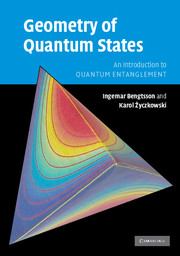Book contents
- Frontmatter
- Contents
- Preface
- 1 Convexity, colours and statistics
- 2 Geometry of probability distributions
- 3 Much ado about spheres
- 4 Complex projective spaces
- 5 Outline of quantum mechanics
- 6 Coherent states and group actions
- 7 The stellar representation
- 8 The space of density matrices
- 9 Purification of mixed quantum states
- 10 Quantum operations
- 11 Duality: maps versus states
- 12 Density matrices and entropies
- 13 Distinguishability measures
- 14 Monotone metrics and measures
- 15 Quantum entanglement
- Epilogue
- Appendix 1 Basic notions of differential geometry
- Appendix 2 Basic notions of group theory
- Appendix 3 Geometry: do it yourself
- Appendix 4 Hints and answers to the exercises
- References
- Index
Appendix 3 - Geometry: do it yourself
Published online by Cambridge University Press: 27 August 2009
- Frontmatter
- Contents
- Preface
- 1 Convexity, colours and statistics
- 2 Geometry of probability distributions
- 3 Much ado about spheres
- 4 Complex projective spaces
- 5 Outline of quantum mechanics
- 6 Coherent states and group actions
- 7 The stellar representation
- 8 The space of density matrices
- 9 Purification of mixed quantum states
- 10 Quantum operations
- 11 Duality: maps versus states
- 12 Density matrices and entropies
- 13 Distinguishability measures
- 14 Monotone metrics and measures
- 15 Quantum entanglement
- Epilogue
- Appendix 1 Basic notions of differential geometry
- Appendix 2 Basic notions of group theory
- Appendix 3 Geometry: do it yourself
- Appendix 4 Hints and answers to the exercises
- References
- Index
Summary
In this appendix we provide some additional exercises of a more practical nature.
Exercise 3.1 – Real projective space. Cut out a disc of radius r. Prepare a narrow strip of length πr and glue it into Möbius strip. The total length of the boundary of a strip is equal to the circumference of the disc so you may try to glue them together. When you are finished, you can contemplate a fine model of a real projective space, ℝP2.
Exercise 3.2 – Hypersphere S3 may be obtained by identifying points on the surfaces of two identical 3-balls as discussed in Section 3.1. To experience further features of the hypersphere get some playdough and prepare two cylinders of different colours with their length more than three times larger than their diameter. Form two linked tori as shown in Figure A3.2.
Start gluing them together along their boundaries. After this procedure is completed, you will be in position to astonish your colleagues by presenting them a genuine Heegard decomposition of a hypersphere.
Exercise 3.3 – Mixed states. Make a ball out of playdough. Glue a string to its surface along the shape of the stitching of a tennis ball (see Figure A3.3). Obtain a convex hull by cutting out the redundant dough with a knife. How much of a ball is taken away?
Convince yourself that the convex hull of a one-dimensional string located at S2 forms a considerable part of the ball B3. In a similar way M(3) – the convex hull of four-dimensional manifold ℂP2 consisting of N = 3 pure states placed at S7 contains a non-negligible part of B8 (see Section 14.3).
- Type
- Chapter
- Information
- Geometry of Quantum StatesAn Introduction to Quantum Entanglement, pp. 424 - 427Publisher: Cambridge University PressPrint publication year: 2006



